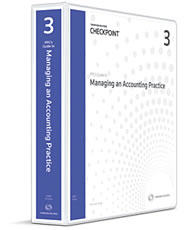The right accounting firm structure combined with a good financial management strategy can lead to a profitable outcome.
Do you have an interest in one day becoming a partner or owner of a small to mid-sized accounting firm? If so, it is important to be aware of the responsibilities and rewards it entails, which includes having a clear understanding of accounting firm economics.
While the role of a partner may vary from firm to firm, there are several key responsibilities that are shared among all of the owners. These include business management (i.e., resource management, staff management, quality management, etc.), business direction and strategy, and financial management.
Navigating the business development side can be exciting and rewarding, but it is important to keep in mind that assuming a position of authority within a firm will be a marked shift in your career. Balancing the risks and rewards is critical.
To help professionals in their pursuit to become a successful partner, this article will explore how accounting firm structures work, accounting firm financial management, and how to fuel business opportunities through strategic advisory services.
Jump to ↓
| Accounting firm structures at small-to-mid-sized firms |
| Accounting firm financial management |
| What is a good profit margin for an accounting firm? |
| Opportunities for growth with advisory services |
Accounting firm structures at small-to-mid-sized firms
When structuring an accounting firm, it is important to be aware that there’s no one-size-fits-all approach.
A smaller-sized firm (generally 1-6 people) will typically have a more straightforward structure; whereas a mid-sized firm (~7-25 people) may have a more diverse structure. However, what is beneficial when structuring a firm is to first take a step back and evaluate factors like the firm’s size, internal processes, client services, and long-term goals.
Evaluating these factors can help firms establish the structure that best meets their needs and the needs of their clients.
In general, the owner of a small firm will be in charge of higher-level strategic business decisions and will handle such duties as financial decision-making and day-to-day operational management. If there are two partners, they will share this work.
In mid-sized firms, the partners typically lead the business development, growth plans, and strategic vision of the firm, while also performing some of the work of an accountant. Next down in this hierarchy are the firm’s managers, accountants, and administrative staff.
It is also interesting to note that, in recent years, given the rise of strategic advisory services, there has been talk of the shift from a triangle-shaped organizational structure to a diamond-shaped structure, as the corners on the base of the traditional triangle organizational chart become increasingly automated.
In the diamond-shaped structure, strategic leadership is at the top. This is followed by business partners who provide guidance to help drive organizational value, then specialists who focus on their areas of expertise, and then the management of processes to gather and extract data.
Accounting firm financial management
It is important for an accounting firm to have solid financial management to help ensure it maximizes profitability and cash flow, remains compliant, and achieves its strategic goals. Focusing on three key areas — client services, pricing, and a growth strategy — can help position firms for success.
Client services
In today’s complex market, clients are increasingly seeking strategic business advice, and a growing number of firms are heeding the call. For example, the Thomson Reuters 2024 State of Tax Professionals Report found that 45% of mid-size firm respondents said their firms currently offer business consulting and 23% more are considering it. And among smaller firms, more than half (52%) of small firm respondents said their firms either already provide business consulting services or are considering it.
As the research noted, a similar dynamic is playing out in other service areas such as financial planning, decision-support, and tax strategy.
Accountants who are looking to become firm owners or partners must keep pace with the market forces impacting the profession and understand the important role that forward-looking consulting services can play in remaining competitive.
Pricing
A growing number of firms are not only rethinking the services they provide but also their pricing structure. For today’s firm owners and partners, this means rethinking the traditional hourly billing model.
In today’s competitive environment, the shift away from hourly billing continues to gain momentum as pricing models have become a strategic tool to help boost revenues. This shift is due, in part, to the fact that as firms diversify their service offerings, particularly advisory services, it is critical that they are properly compensated for the value and expertise they deliver.
As a result, a growing number of firms are now offering a variety of pricing models, from project-based and flat-fee pricing to market-value pricing, value-based pricing, and retainers. The model gaining the most traction in 2024 is value-based pricing.
Under the value-based pricing model, the firm charges based on expertise, guidance, and results rather than time spent on a particular task. According to Thomson Reuters research, nearly half (48%) of respondents said their firms already offer value-based pricing on some of their services, and 18% said their firms plan to start offering it by the end of the year.
Again, having the right pricing structure in place is an important factor that firm owners and partners must think about when looking to drive revenue in today’s dynamic market.
Growth strategy
Does your firm have a deliberate growth strategy in place? If not, it may be something to consider as a firm owner or partner. According to the Tax Professionals report, 38% of respondents in the 2024 survey said their firms had a growth strategy in place for the coming year.
In looking at the factors influencing growth strategy, the research found that growing the client base (65%), greater use of technology and automation (57%), and obtaining more work from existing clients (45%) topped the list.
Given the findings, accountants who are looking to become a firm owner or partner are wise not to overlook the importance of developing a competitive growth strategy.
 |
|
What is a good profit margin for an accounting firm?
This is a common question that is likely top of mind for many firm owners and partners. And it can be a difficult one to answer as profit margins can vary significantly by industry.
It has been reported that firms that provide accounting, bookkeeping, tax prep, and payroll services generate on average a net profit margin of nearly 20%.
What is important to keep in mind is that a “good” profit margin really depends on the goals of the firm. Is your firm compliance focused? Or are you looking to expand into more strategic advisory services?
Firms that deliver more strategic advisory services are ideally positioned to collect higher billing rates, which is certainly a factor that impacts profitability. When clients understand the value and expertise your firm provides, they are more willing to pay a premium for those higher-margin advisory services.
Opportunities for growth with advisory services
In light of increased client demands, a complex regulatory environment, and advancements in technology, more and more firms are rethinking their business models to provide more higher-value, higher-margin advisory services. Is your firm among them?
Unlike a rearview mirror approach to accounting, advisory services focus on looking ahead and providing clients with proactive, strategic guidance. Providing such services enables owners and partners to attract more new clients and upsell current clients as research shows that clients want more business advice. More specifically, clients are looking for help with business advice like tax strategies (90%), financial planning (69%), and decision support (47%).
It is also important to understand the barriers that firm owners and partners may face when looking to provide the requested advisory services. Such commonly cited barriers include lack of expertise, and time and staffing constraints. The good news is that leveraging the right technology tools and resources can help firms improve efficiencies, drive greater automation, and broaden bandwidth to meet the rise in client demands.
Remain competitive and add greater value and profitability to your firm by offering advisory services. Turn to Thomson Reuters Practice Forward for a proven roadmap to success.
 |
|










